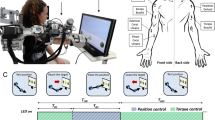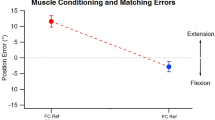Abstract.
Human proprioceptive performance of movement detection in joints is currently believed to be based on information from muscle spindles. In previous studies investigating proprioception, we found remarkable differences in threshold values using a conventional movement-detection paradigm and a threshold-hunting paradigm. One reason could be that central processing, the evaluation of the peripheral sensation, was responsible. Therefore, the study was designed to determine, besides the proprioceptive performance, the central processing of movement detection in the knee joint by means of a signal-detection technique (SDT). Only this technique provides parameters such as detectability (d′) and the decision criterion (β), which distinguish between these performances. From the resulting psychometric functions, the threshold (a parameter of classical psychophysics) also was evaluated. This threshold parameter (PCmax), derived from the SDT parameter d′, indicates that detection is above threshold when subjects detect only 20–30% of the applied stimuli, as sham stimuli were detected also. The detectability increased with increasing velocity and up to a certain value with increasing amplitude. The threshold for movement detection was lower than 0.25° for the three faster angular velocities (0.1° s–1, 0.5° s–1, 0.6° s–1) and lower than 0.75° for the slowest velocity (0.05° s–1). The decision criterion β, a measure for central processing which determines acuity, might reflect the central processing output on fusimotor neurones and thus be an indirect measure of the γ-drive evoked by fusimotor neurones.
Similar content being viewed by others
Author information
Authors and Affiliations
Additional information
Electronic Publication
Rights and permissions
About this article
Cite this article
Weiler, HT., Awiszus, F. Characterisation of human knee-joint proprioception by means of a signal-detection theory. Exp Brain Res 138, 110–117 (2001). https://doi.org/10.1007/s002210100692
Received:
Accepted:
Issue Date:
DOI: https://doi.org/10.1007/s002210100692




